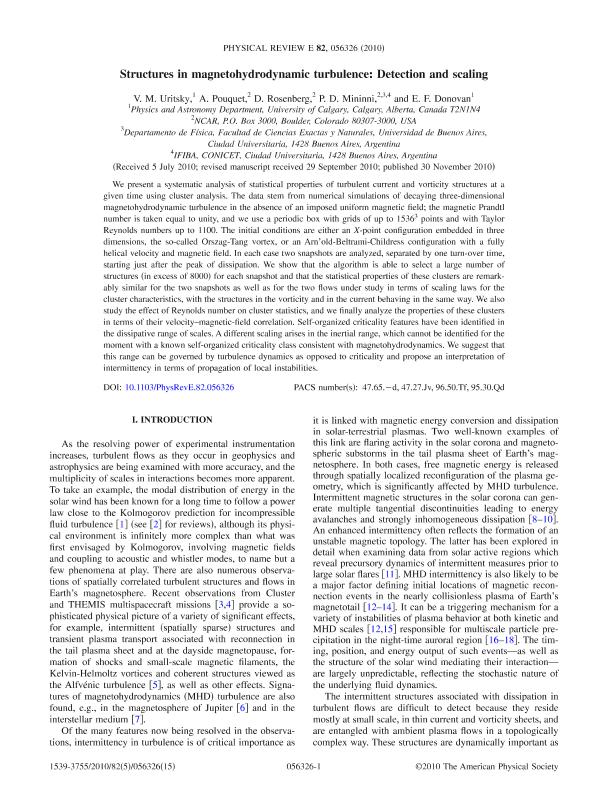Mostrar el registro sencillo del ítem
dc.contributor.author
Uritsky, Vadim

dc.contributor.author
Pouquet, A.
dc.contributor.author
Rosenberg, Duane

dc.contributor.author
Mininni, Pablo Daniel

dc.contributor.author
Donovan, E.F.
dc.date.available
2018-08-27T14:24:22Z
dc.date.issued
2010-11
dc.identifier.citation
Uritsky, Vadim; Pouquet, A.; Rosenberg, Duane; Mininni, Pablo Daniel; Donovan, E.F.; Structures in magnetohydrodynamic turbulence: Detection and scaling; American Physical Society; Physical Review E: Statistical, Nonlinear and Soft Matter Physics; 82; 5; 11-2010; 5632601-5632615
dc.identifier.issn
1539-3755
dc.identifier.uri
http://hdl.handle.net/11336/57155
dc.description.abstract
We present a systematic analysis of statistical properties of turbulent current and vorticity structures at a given time using cluster analysis. The data stem from numerical simulations of decaying three-dimensional magnetohydrodynamic turbulence in the absence of an imposed uniform magnetic field; the magnetic Prandtl number is taken equal to unity, and we use a periodic box with grids of up to 15363 points and with Taylor Reynolds numbers up to 1100. The initial conditions are either an X -point configuration embedded in three dimensions, the so-called Orszag-Tang vortex, or an Arn'old-Beltrami-Childress configuration with a fully helical velocity and magnetic field. In each case two snapshots are analyzed, separated by one turn-over time, starting just after the peak of dissipation. We show that the algorithm is able to select a large number of structures (in excess of 8000) for each snapshot and that the statistical properties of these clusters are remarkably similar for the two snapshots as well as for the two flows under study in terms of scaling laws for the cluster characteristics, with the structures in the vorticity and in the current behaving in the same way. We also study the effect of Reynolds number on cluster statistics, and we finally analyze the properties of these clusters in terms of their velocity-magnetic- field correlation. Self-organized criticality features have been identified in the dissipative range of scales. A different scaling arises in the inertial range, which cannot be identified for the moment with a known self-organized criticality class consistent with magnetohydrodynamics. We suggest that this range can be governed by turbulence dynamics as opposed to criticality and propose an interpretation of intermittency in terms of propagation of local instabilities. © 2010 The American Physical Society.
dc.format
application/pdf
dc.language.iso
eng
dc.publisher
American Physical Society

dc.rights
info:eu-repo/semantics/openAccess
dc.rights.uri
https://creativecommons.org/licenses/by-nc-sa/2.5/ar/
dc.subject
Magnetohydrodynamics And Electrohydrodynamics
dc.subject
High-Reynolds-Number Turbulence
dc.subject
Mhd Waves
dc.subject
Plasma Waves, Turbulence, Magnetohydrodynamics And Plasmas
dc.subject.classification
Astronomía

dc.subject.classification
Ciencias Físicas

dc.subject.classification
CIENCIAS NATURALES Y EXACTAS

dc.title
Structures in magnetohydrodynamic turbulence: Detection and scaling
dc.type
info:eu-repo/semantics/article
dc.type
info:ar-repo/semantics/artículo
dc.type
info:eu-repo/semantics/publishedVersion
dc.date.updated
2018-08-24T13:44:47Z
dc.journal.volume
82
dc.journal.number
5
dc.journal.pagination
5632601-5632615
dc.journal.pais
Estados Unidos

dc.journal.ciudad
Nueva York
dc.description.fil
Fil: Uritsky, Vadim. University of Calgary; Canadá
dc.description.fil
Fil: Pouquet, A.. National Center for Atmospheric Research; Estados Unidos
dc.description.fil
Fil: Rosenberg, Duane. National Center for Atmospheric Research; Estados Unidos
dc.description.fil
Fil: Mininni, Pablo Daniel. Consejo Nacional de Investigaciones Científicas y Técnicas. Oficina de Coordinación Administrativa Ciudad Universitaria. Instituto de Física de Buenos Aires. Universidad de Buenos Aires. Facultad de Ciencias Exactas y Naturales. Instituto de Física de Buenos Aires; Argentina
dc.description.fil
Fil: Donovan, E.F.. University of Calgary; Canadá
dc.journal.title
Physical Review E: Statistical, Nonlinear and Soft Matter Physics

dc.relation.alternativeid
info:eu-repo/semantics/altIdentifier/url/http://link.aps.org/doi/10.1103/PhysRevE.82.056326
dc.relation.alternativeid
info:eu-repo/semantics/altIdentifier/doi/http://dx.doi.org/10.1103/PhysRevE.82.056326
Archivos asociados
